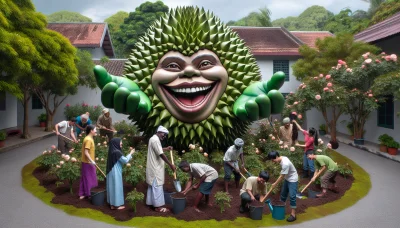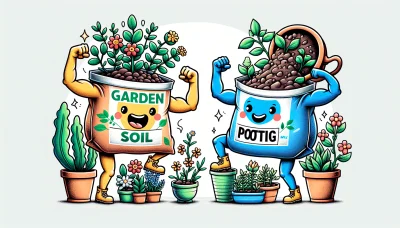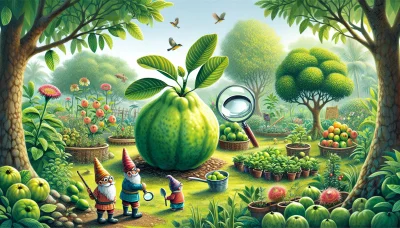Creating Hypertufa Planters Quiz
Test Your Knowledge
Question of
Creating Hypertufa Planters: A Guide for Garden Enthusiasts
Hypertufa planters are a type of artificial stone planter made from a mixture of cement, peat moss, and perlite or vermiculite. This combination creates a lightweight, porous material that is perfect for cultivating plants. They are especially loved by garden enthusiasts for their ability to provide excellent drainage and air circulation to the root system of plants. Additionally, hypertufa planters offer an aesthetic appeal, resembling natural stone but without the weight, making them easy to move and rearrange in your garden. Their durability and resistance to weather conditions also make them a practical choice for both indoor and outdoor gardening projects.
Materials Needed for Hypertifua Planters
- Portland cement
- Sphagnum peat moss
- Perlite or vermiculite
- Water
- Non-metallic mixing container
- Protective gloves
- Face mask
- Molds or forms
- Plastic sheeting
- Wire brush or sandpaper (for finishing)
Step-by-Step Guide to Making Your Own Hypertufa Planters
- Gather Materials: Portland cement, peat moss, perlite, water, and a mold of your choice.
- Protect Yourself: Wear gloves, a dust mask, and safety glasses to protect your skin, lungs, and eyes.
- Mix the Dry Ingredients: In a large container, mix 1 part Portland cement, 1.5 parts peat moss, and 1.5 parts perlite.
- Add Water: Slowly add water and mix until you achieve a consistency similar to cottage cheese.
- Prepare the Mold: Coat your mold with a cooking spray or line it with a plastic bag for easier demolding.
- Fill the Mold: Press the hypertufa mix firmly into the mold. For drainage, make sure to create one or more holes in the bottom.
- Create Texture: If desired, use tools or your hands to add texture to the surface of the hypertufa.
- Cure the Planter: Cover the mold with plastic and let it cure in a cool, shaded area for 24 to 48 hours.
- Demold: Carefully remove the hypertufa planter from the mold. If it resists, let it sit for a few more hours before trying again.
- Final Cure: Allow the planter to cure for an additional 2 to 3 weeks in a shaded area, misting with water occasionally to prevent cracking.
Design Ideas for Hyperturf Planters
Hypertufa planters offer a unique blend of rustic charm and versatility, making them a popular choice for gardeners and DIY enthusiasts alike. These planters can be customized in numerous ways, from their size and shape to their color and texture. For a natural, earthy look, consider adding peat moss or perlite into the mix. For those who prefer a more rugged, stone-like appearance, incorporating different sizes of sand or even small pebbles can achieve that effect. Colorants can also be added to the hypertufa mix to create planters that complement your outdoor decor or to add a pop of color to your garden. Textural designs can be imprinted onto the surface of the planters using leaves, shells, or even fabric, giving each piece a unique and artistic touch. With a little creativity, hypertufa planters can be molded into various shapes, from traditional rounds and squares to more imaginative forms like animal shapes or garden sculptures. The possibilities are endless, allowing you to create a truly personalized garden space.
Caring for Your Hypertufa Planters
Hypertufa planters, known for their porous and natural stone-like appearance, require specific care and maintenance to ensure their longevity and beauty. To properly care for your hypertufa planters, it is essential to cure them correctly after creation, which involves soaking them in water for up to three weeks to leach out lime that can be harmful to plants. Once in use, ensure they are placed in a well-draining area to prevent water from pooling, which can lead to algae growth or frost damage in colder climates. During winter, it's advisable to elevate the planters off the ground to avoid freezing and thawing cycles that can crack the hypertufa. Cleaning the planters occasionally with a stiff brush and water will keep them looking their best. Avoid using harsh chemicals that can erode the surface. With proper care, hypertufa planters can provide a rustic charm to your garden for years to come.
Benefits of Using Hypertufa Planters in Your Garden
- Porosity: Allows for better air and water flow to plant roots, promoting healthier plant growth.
- Aesthetic Appeal: Offers a rustic and natural look that enhances the beauty of any garden space.
- Durability: Highly durable and resistant to harsh weather conditions, ensuring longevity.
- Lightweight: Easier to move and handle compared to traditional stone or concrete planters.
- Customizable: Can be molded into various shapes and sizes to fit any garden design.
- Eco-Friendly: Made from sustainable materials, contributing to environmental conservation.












